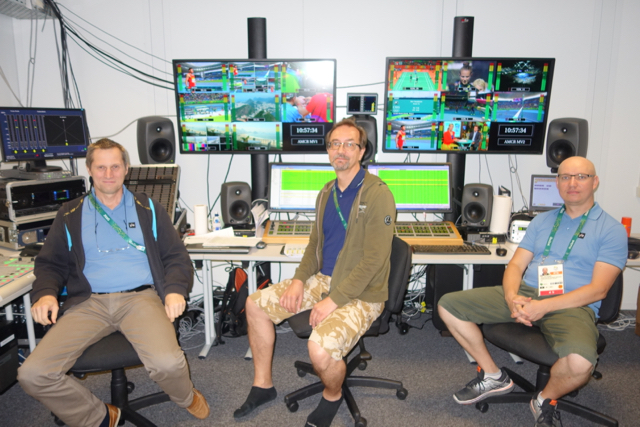Live From Rio 2016: YLE Finland Embraces IP, Remote Production
YLE Finland’s presence at Rio 2016 makes the most of IP technologies and remote production. According to Senior Technical Advisor Kaj Flood, the goal is to continue to pass more production control back to the team in Finland.

From left: YLE Finland’s Kaj Flood, Samuli Ljikanen, and Arttu Horttanainen in the channel’s IBC production-control area
“We’ve expanded the use of remote production so that all we are doing here is just the technical part,” says Flood. “We have 150 people in Helsinki working the Olympics, and we have our biggest OB truck, which has two control rooms, handling the 24/7 channel. Our biggest studio-control room is being used for a second channel, but that channel is not 24/7.”
YLE will broadcast 600 hours of Olympics coverage to viewers back home, and 11 camera operators are on hand in Rio for unilateral production. A studio located in an apartment overlooking Copacabana Beach has four cameras (a beauty camera, two GV cameras, and an RF camera that can shoot live from the beach), and YLE also has a presence at five mixed-zone positions: athletics, shooting, aquatics, sailing, and golf.
The core of the coverage is OBS’s Multichannel Distribution Service (MDS), which is received in Finland via satellite. But the team in Rio steps in to help in those instances when the MDS might not be covering a Finnish athlete. The team in Helsinki can order content (an automation system helps ensure that content requests are fulfilled properly), and there are eight video circuits between YLE’s IBC operation and Helsinki via a 1-Gbps circuit. There is also a 1-Gbps circuit between the Copacabana location and the IBC.
“If there are three wrestling matches going on and the MDS is not showing the Finnish match, then we can get [Helsinki] the correct match,” says Flood. “Otherwise, the lines are used for sending the mixed-zone signals.”
Two production switchers at the IBC perform a premix on the Copacabana-studio cameras, as well as a premix of athletics coverage. An EVS XT3 server records athletics signals, and three Avid edit suites are used for creating feature packages.
Lawo V__remote4 IP systems are being used to help with IP transport of audio and video signals. Also playing a part in the IP workflow are Ravenna audio-over-IP transport and Riedel Artist intercoms.
“It gives us the flexibility to do whatever we want to change the mixed-zone channel operations,” says Flood.
Operations are going smoothly, the only glitch being that OBS does not use GPS to lock sync. “If they had that,” he says, “it would make our lives much easier. We have been using GPS for seven years in Helsinki as it makes for a much more robust network.”
